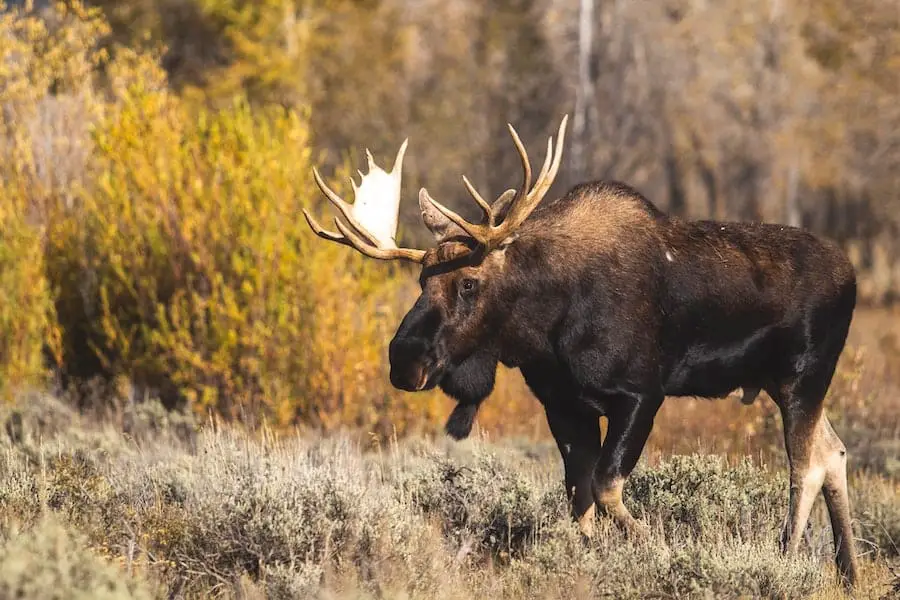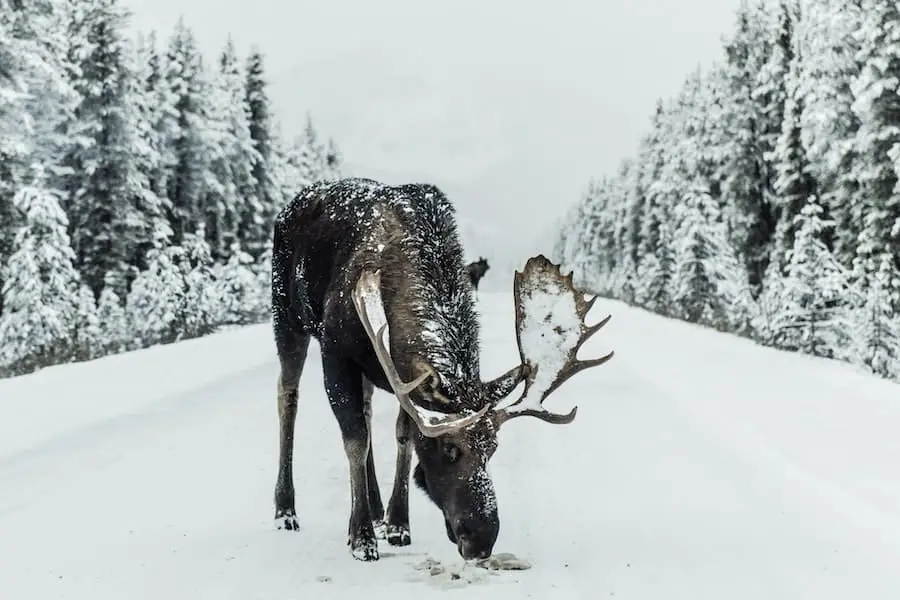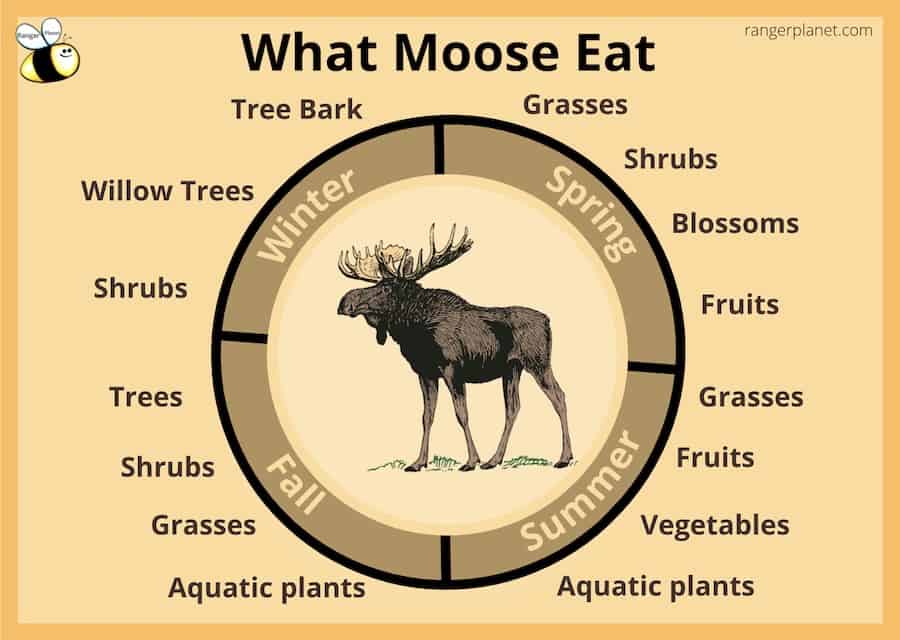You might be wondering this as you see a moose along the side of the road or when hiking. Moose are commonly known as the largest animal in the deer family. They are indeed majestic animals. And they need to eat a lot of food for their size and weight. But exactly what do moose eat?
This article will give a clear understanding of what moose eat. Their eating patterns through the seasons. Plus how much they eat. And, how they maintain their large size through their diet and through the year. Let’s start with a summary…
Moose are herbivores that feed on plants. In spring they eat spring blooms, grass, and shrubs. In summer, they include more grass, vegetables, and aquatic plants. During winter they feed on Willow. During severe cold weather, they eat tree bark. In general, Moose prefer rare plants over common ones.
Eating patterns of animals is always exciting. And eating patterns and behaviors are probably more exciting when it comes to larger animals like moose.
Moose can grow up to 7 feet tall, taller than most horses. So you really do not want to get in their way or provoke them.
And for large animals like these, what they eat to keep up their large size and remain healthy is important. So their diet can – and does change.
And like most animals, a moose diet must include certain nutrients, vitamins, and minerals, wherever they’re available. Which is largely determined by their location and the season.
Read on, or watch the video below from the Ranger Planet Youtube Channel.
Moose are herbivores – they eat plant matter
Moose is an herbivore, which means their diet consists of plants and all things green.
But because they are huge, where an adult male can weigh up to 1,300 pounds, it requires a lot of vegetation to fulfill the required daily, weekly, and annual diet of a moose.
On average, a moose eats about forty pounds of vegetation per day. But this can be up to around 70 pounds per day. This is what they need to attain the required 10,000 calories they need daily.
However, when it comes to their food patterns, despite their need to consume a large volume, they are more discerning and selective than you might think. More particularly in certain seasons when the availability of preferred plant matter is more abundant.

What moose eat in line with the seasons
The best way to look at this is to track the moose diet through the seasons. Because the season in which you see them eating will be part of a larger eating annual cycle.
Let’s start in Spring…
What moose eat in Spring
In spring, moose that have made it through the winter months use up their stored fat reserves. They’re keen to increase their weight once more.
Mostly, they will seek out tall grasses, blossoms, and fruits. Moose are also commonly found feeding on agricultural produce.
During spring in the northeastern United States, they’ve been known to feed on a wide variety of fruits and vegetables, from watermelons to brussels sprouts.
The abundance in growth that Spring brings, provides moose with much-needed nutrition. It’s their best opportunity to restock on important nutrients prior to next winter when greenery once again becomes scarce.
By May, moose have returned to areas such as the old crow flats in Canada, near the Alaskan border to undertake much of this feeding.
What moose eat in Summer
In summer, in these more northern locations, Moose eat an abundance of grasses. But will also be found later in summer in marshes and lakes – feeding on aquatic plant matter such as marsh reeds and duckweed.
They still mainly eat grass, however, because the wide abundance of tall grasses allows them to feed on an almost constant basis.
Summer, like Spring, is a time for over-eating. Like many animals, they will have recouped any lost weight by this point but will continue to store fat reserves. They will continue to gain more weight in preparation for late fall and winter and for the mating season which occurs from September through October.
In mid to late Summer, moose gravitate towards feeding more on aquatic plants.
This is an opportunity to regain and refill the much-needed sodium and mineral requirements that they lost during the winter.
What moose eat in Fall
In the fall their diet heavily depends on the weather, the place, or territory they remain in – or even move to. As moose do migrate during this time in preparation for the onset of winter, as evidenced during a major tracking project.
Moose move to where food is generally more abundant, migrating generally further south, around the Canada and US border. this means often finding and feeding on whatever grasses they can locate, or even available trees.
What moose eat in Winter

If living through the harsh winter, however, they prefer to feed more on willow, as it’s a tree that is packed heavily with necessary proteins.
They also like other trees such as trembling aspen and black poplar. With red osier being a particular favorite.
If and when the winter season becomes severe, and when grass and greeneries dry up altogether, they may resort to eating the bark right from the tree.
Moose will routinely strip the bark off of standing trees, as well as fallen and decaying trees that may be as much as three years old.
Of course, these are not necessarily part of a nutritional diet, but more to fill their stomach to help them survive through the season. And who knows what other animal proteins they might also unintentionally consume while eating bark.
Having said that, moose are strictly herbivores, and that brings us to the question, how can moose maintain their huge size with only vegetation for sustenance.
Can you outrun a moose? – Here’s the answer
Moose food patterns and their size
As moose are very large creatures, it’s natural to understand they need a heavy diet and high nutrition intake to keep healthy and to keep them fueled.
But because they are herbivores, vegetation and greenery alone may not provide moose with the required nutrition they need, and that meat could provide.
Because of the complexities that moose have with their diet and size, they tend to be very choosy about their habitat and territories.
Moose usually frequent a territory that has greater access to nutritional plants.
Places like recently burnt down forests after a fire are chosen as an ideal place for moose to set up territories and it’s easy to find moose establishing themselves in such places.
Forests recently destroyed by fire are more likely to have fresh and young blooms that are highly nutritional.
Moose also prefer to establish territories near waterways such as the crows, which can give them good access to aquatic plants – which are again high in nutritional values.
Using these locational techniques allows a moose to feed on sufficient nutrients to maintain its size.
This nutritional feeding pattern …supported by well-chosen territories, directly affects producing healthy offspring.
Keep reading on, but If you’ve learned something so far then why not share or Pinterest this, see below…

Moose seek out nutritionally high food
In their quest for nutritionally valuable food. Moose eat a wide variety of plants, fruits, and seeds.
But the majority of their diet consists of flowering plants, fresh shoots from growing trees, and of course other available aquatic vegetation.
Moose can easily devour an entire branch of leaves, dandelions in large quantities pulled directly from the ground, and even roots.
But finding sufficient foliage depends largely on the geographical locations they establish their territories within.
Moose diet preferences
Although Moose literally can and do eat most vegetation and greenery. They can be choosy when it comes to dining preferences. For trees, they are often happiest when eating willow, aspen, and balsam fir
Moose can be more discerning in their taste when there are plenty of choices available – and of course depending on the geographical location.
It’s believed that moose prefer very rare plants over those that are often available. When more rare plants are available, moose often turn their nose up on common plants, in search of the rarer tastes.
Over time, the risk of predation, hunting, and changing weather patterns has forced moose to adapt, and often times this means feeding on whatever is available.
Downsides To What Moose Chooses To Eat
Not all the food choices of a moose might be considered good choices.
In difficult times, any old bark they find and eat may not always be healthy. Moose also heavily feed on aquatic plants.
There are downsides that come along with eating aquatic plant matter for moose. As we know moose are herbivores and don’t eat meat. Sadly, when moose feed on aquatic plants in the water, they can accidentally eat snails.
Snails can carry a deadly parasite that’s called a brain worm.
Larvae that are present in the snail can migrate to the Moose’s brain causing neurological damage. In many cases, the neurological damage caused leads to death.
More moose!
I hope this has helped answer the question of what do moose eat. The next question I might ask is, can you tell the difference between an Elk and a Moose. Be sure to read our other informative articles on rangerplanet.com.
I’ll leave you with this question – Can you outrun a moose?
